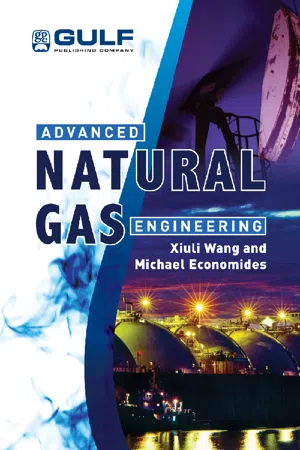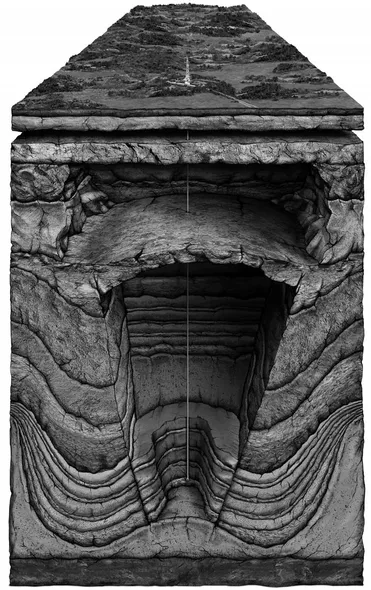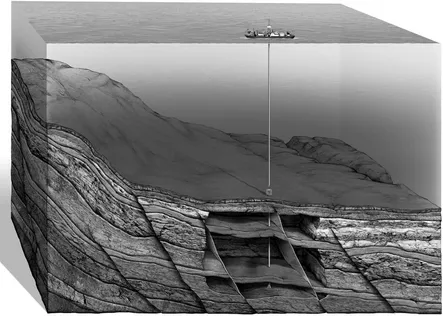
- 368 pages
- English
- ePUB (mobile friendly)
- Available on iOS & Android
eBook - ePub
Advanced Natural Gas Engineering
About this book
Natural gas is playing an increasing role in meeting world energy demands because of its abundance, versatility, and its clean burning nature. As a result, lots of new gas exploration, field development and production activities are under way, especially in places where natural gas until recently was labeled as "stranded. Because a significant portion of natural gas reserves worldwide are located across bodies of water, gas transportation in the form of LNG or CNG becomes an issue as well. Finally natural gas is viewed in comparison to the recently touted alternatives. Therefore, there is a need to have a book covering all the unique aspects and challenges related to natural gas from the upstream to midstream and downstream. All these new issues have not been addressed in depth in any existing book. To bridge the gap, Xiuli Wang and Michael Economides have written a new book called Advanced Natural Gas Engineering. This book will serve as a reference for all engineers and professionals in the energy business. It can also be a textbook for students in petroleum and chemical engineering curricula and in training departments for a large group of companies.
Frequently asked questions
Yes, you can cancel anytime from the Subscription tab in your account settings on the Perlego website. Your subscription will stay active until the end of your current billing period. Learn how to cancel your subscription.
At the moment all of our mobile-responsive ePub books are available to download via the app. Most of our PDFs are also available to download and we're working on making the final remaining ones downloadable now. Learn more here.
Perlego offers two plans: Essential and Complete
- Essential is ideal for learners and professionals who enjoy exploring a wide range of subjects. Access the Essential Library with 800,000+ trusted titles and best-sellers across business, personal growth, and the humanities. Includes unlimited reading time and Standard Read Aloud voice.
- Complete: Perfect for advanced learners and researchers needing full, unrestricted access. Unlock 1.4M+ books across hundreds of subjects, including academic and specialized titles. The Complete Plan also includes advanced features like Premium Read Aloud and Research Assistant.
We are an online textbook subscription service, where you can get access to an entire online library for less than the price of a single book per month. With over 1 million books across 1000+ topics, we’ve got you covered! Learn more here.
Look out for the read-aloud symbol on your next book to see if you can listen to it. The read-aloud tool reads text aloud for you, highlighting the text as it is being read. You can pause it, speed it up and slow it down. Learn more here.
Yes! You can use the Perlego app on both iOS or Android devices to read anytime, anywhere — even offline. Perfect for commutes or when you’re on the go.
Please note we cannot support devices running on iOS 13 and Android 7 or earlier. Learn more about using the app.
Please note we cannot support devices running on iOS 13 and Android 7 or earlier. Learn more about using the app.
Yes, you can access Advanced Natural Gas Engineering by Xiuli Wang,Michael Economides in PDF and/or ePUB format, as well as other popular books in Technology & Engineering & Fossil Fuels. We have over one million books available in our catalogue for you to explore.
Information
CHAPTER 1
Natural Gas Basics
1.1 Introduction
At the time of the writing of this book, natural gas provided about 23% of the total world energy supply, and that share would certainly increase. While coal is a solid and oil is a liquid, natural gas is a gaseous-phase fossil fuel. It is colorless, odorless, shapeless, and lighter than air. When burned, it gives off about 1,000 Btu (British thermal unit) per scf (standard cubic foot) and is used for domestic applications such as space heating, cooking and, increasingly, to generate electricity. It only ignites when the air-and-gas mixture is between 5 and 15 percent natural gas.
When compared with coal and oil, it burns cleaner, more efficiently, and with lower levels of potentially harmful byproducts that are released into the atmosphere. More important, there are very large deposits of natural gas in the world—far more than oil—Because this resource is difficult to transport, a lot of it has been labeled as “stranded.” For these reasons, there has been a considerable increase in new gas exploration, field development, and production activities. To develop a natural gas field, one of the first important steps is to understand the fundamentals of natural gas. What follows is a summary of basic petroleum geology, natural gas origins, resources, and properties.
1.2 Geological Settings
Petroleum reservoirs, both oil and gas, are the result of sedimentary processes that happened over an extensive geological history. Figures 1-1 and 1-2 show artistic cutaways of two reservoirs, one onshore and another offshore. It is important for the reader to conceptualize how petroleum reservoirs are configured underground, at great depths and, at times, also under many thousands of feet of water.

Figure 1-1 Artist’s rendition of onshore petroleum reservoir (Graphics by John Perez Graphics & Design, LLC)

Figure 1-2 Artist’s rendition of offshore petroleum reservoir (Graphics by John Perez Graphics & Design, LLC)
Different geological settings have led to sandstone, carbonate, or conglomerate lithologies. Figure 1-3 represents an artist’s rendition of one common type of sedimentary settings with features that eventually would evolve into different types of reservoirs.

Figure 1-3 Sedimentary environment
Petroleum geology not only attempts to reconstruct these ancient settings through the use of observations, well information, and seismic measurements, but also to apply logical inferences in searching for better quality reservoirs. This happens even within well-established sedimentary environments. For example, consider the detail in Figure 1-3 of a meandering channel. Identifying the channel may indicate the desired site of a well, whether a horizontal well is drilled (perpendicular or longitudinal) or, if complex well architecture is indicated, such as a “fishbone” configuration. Well architecture must take into account the shape of the geological units to be produced.
The second detail in Figure 1-3 shows how sediments are likely to be deposited, even inside a channel. Depending on the bending of the channel, one side will be conducive to deposition and the other conducive to erosion. Clearly, one would be looking for a petroleum accumulation at the likely depositional side.
The depth of a structure becomes critical for a number of important properties. The deeper the formation, the more likely it will be compacted as the grains are finer and consolidated. Secondary cementation processes are usually responsible for rock consolidation as cementing materials have percolated through the rock over geologic time. Shallow reservoirs are likely to consist of coarser materials and are likely to be unconsolidated.
There is gradation between deep highly consolidated rocks at, e.g., 20,000 ft depth and highly u...
Table of contents
- Cover image
- Title page
- Table of Contents
- Copyright
- Preface
- Reviews
- List of Figures
- List of Tables
- List of Examples
- Chapter 1: Natural Gas Basics
- Chapter 2: Unique Issues in Natural Gas Exploration, Drilling, and Well Completion
- Chapter 3: Natural Gas Production
- Chapter 4: Natural Gas Processing
- Chapter 5: Natural Gas Transportation—Pipelines and Compressed Natural Gas
- Chapter 6: Liquefied Natural Gas (LNG)
- Chapter 7: Gas-To-Liquids (GTL)
- Chapter 8: Underground Natural Gas Storage
- Chapter 9: Natural Gas Supply, Alternative Energy Sources, and the Environment
- Nomenclature
- Index